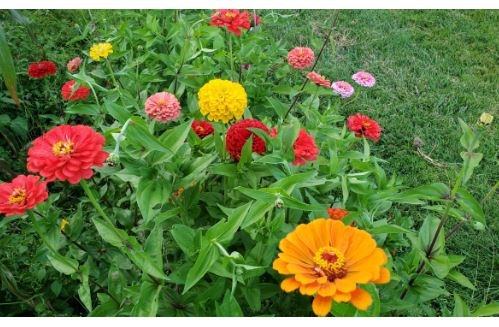
Zinnia is a genus of plants of the tribe Heliantheae within the family Asteraceae. They are native to scrub and dry grassland in an area stretching from the Southwestern United States to South America, with a centre of diversity in Mexico. Members of the genus are notable for their solitary long-stemmed 12 petal flowers that come in a variety of bright colors. The genus name honors the German scientist Johann Gottfried Zinn (1727–1759).
Zinnias are annual flowering plants known for their bright, colorful flowers. They come in various sizes, from dwarf varieties suitable for borders to tall types ideal for cutting gardens. The leaves are opposite, simple, and often lance-shaped, with a rough texture due to fine hairs.
Zinnia flowers have a daisy-like appearance with a central disk surrounded by petals (ray florets). The central disk can be flat, dome-shaped, or even globe-like in some varieties. They come in an extensive color palette, including shades of red, orange, yellow, pink, purple, white, and green. Some varieties also display bicolor patterns or have petals with contrasting edges.
Zinnias are easy to grow with potential heavy, brightly colored blooms. Their petals can take different forms as single row with a visible center (single-flowered zinnia), numerous rows with a center that is not visible (double-flowered) and petals that are somewhere in-between with numerous rows but visible centers (semi-double-flowered zinnia). Their flowers can also take several shapes.
Zinnias are highly attractive to pollinators, especially butterflies, bees, and hummingbirds, making them excellent for wildlife gardens.
Cultivation
Climate and Planting
- Zones: Zinnias are generally grown as annuals in all USDA hardiness zones, thriving in temperatures between 60-75°F (15-24°C).
- Planting Time: Plant zinnias after the last frost when the soil has warmed. They can be sown directly into the garden or started indoors for an earlier bloom time.
Soil:
- They prefer well-draining soil with a slightly acidic to neutral pH. Enriching the soil with compost can encourage robust growth.
Light:
- Zinnias require full sun, meaning at least 6 hours of direct sunlight per day. More sun will promote better flowering.
Watering
- Water regularly but avoid overwatering to prevent root rot. Zinnias are relatively drought-tolerant once established but will produce more flowers with consistent moisture.
Spacing:
- Space plants or seedlings according to the mature size of the variety. Small zinnias might need 6-12 inches, while larger varieties could require 12-24 inches.
Fertilization
- Use a balanced fertilizer at planting time. Too much nitrogen can result in lush foliage at the expense of flowers. A light application of fertilizer during the growing season can help, but avoid over-fertilizing.
Maintenance
- Deadheading: Removing spent flowers (deadheading) encourages more blooms.
- Pinching: For bushier growth and more flowers, pinch back the tips when the plants are about 12 inches tall.
Pests and Diseases
- Pests: Zinnias can be affected by aphids, spider mites, and caterpillars. Use insecticidal soap or neem oil for control.
- Diseases: Susceptible to powdery mildew, especially in humid conditions. Good air circulation and not crowding plants can help prevent this.
Cut Flowers
- Zinnias make excellent cut flowers. Cut them when the lower petals are just beginning to open for the longest vase life.
Special Cultivation Tips
- Variety Selection: Choose varieties based on your garden’s aesthetic or functional needs; some zinnias are bred for disease resistance or flower size.
- Succession Planting: For continuous bloom, plant zinnias in succession every few weeks.